It was too obvious not to do it. Let AI summarise the Department of Education’s guidance. Sure, while I’m at it, I may as well use AI to create the show notes:Explore the safe, ethical, and responsible use of AI for primary educators and school leaders. We share practical examples, such as how a second class teacher can use Generative AI (GenAI) to create curriculum-aligned math activities, or how a fifth class teacher uses GenAI for visual support in Irish lessons. Learn strategies for integrating AI, including the essential 4P framework (Purpose, Planning, Policies, Practice). Remember to maintain human oversight and review all AI outputs for accuracy and bias. Resources like the DALI4US project support data literacy for primary teachers.😱Eek… what about a summary using Notebook LM?Woah! (Ignore the American spelling)Artificial Intelligence in Schools: A Strategic BriefingExecutive SummaryThis briefing synthesizes the core principles, practical applications, and strategic recommendations outlined in the “Guidance on Artificial Intelligence in Schools.” The guidance establishes a foundational framework for school leaders and teachers to navigate the integration of Artificial Intelligence (AI), particularly Generative AI (GenAI), into the educational landscape. It posits that while AI offers significant potential to support teaching, learning, and school administration, its adoption must be responsible, planned, and informed to mitigate inherent risks related to safety, privacy, bias, and academic integrity.The central tenet of the guidance is the principle of human agency and oversight, asserting that AI should serve as a tool to complement and enhance, but never replace, the professional judgment of educators. A key strategic recommendation is the adoption of the 4P Approach (Purpose, Planning, Policies, Practice) as a practical framework for implementation. This approach advocates for aligning AI use with clear educational goals within a school’s digital learning plan, reviewing and updating existing school policies rather than creating new ones, and embedding critical, ethical practices into daily use. The document is designated as a “living document,” acknowledging the rapid evolution of AI and committing to ongoing review and updates based on emerging research, regulatory changes like the EU AI Act, and feedback from the school system.Core Principles for Ethical AI AdoptionThe guidance establishes a clear ethical framework for the use of AI in schools, grounded in seven key requirements for trustworthy AI. These principles are essential for ensuring that AI is deployed in a safe, fair, and effective manner.1. Human Agency and OversightThis is the cornerstone principle, emphasizing that AI systems must empower humans and operate under their control.* The “Human in the Loop”: Educators must act as the final checkpoint, systematically reviewing and validating all AI-generated outputs for accuracy, bias, and reliability.* Mitigating Risks: Human oversight is crucial for managing the risks of GenAI, which include:* Hallucinations: Outputs that seem plausible but are factually incorrect.* Bias: AI models can reflect and amplify biases present in their training data, potentially disadvantaging certain groups.* Disinformation: The capacity of GenAI to rapidly create and scale misinformation.* Decision-Making: AI should support, not replace, human judgment and decision-making, especially in high-stakes educational contexts.2. Privacy and Data GovernanceProtecting student and staff data is a critical compliance and ethical challenge.* Confidentiality: Content used in a request to a GenAI tool is generally not confidential by default and may be used to train the model. All data provided should be considered public unless otherwise stated.* Data Protection: The inputting of sensitive, proprietary, or personal data into AI systems should be avoided. All use must comply with GDPR.* Anonymization: If data is properly anonymized and cannot be re-linked to an individual, it may not be subject to GDPR principles.3. Technical Robustness and SafetyAI systems deployed in schools must be dependable, secure, and perform as expected.* EU AI Act: The EU AI Act (2024) is the world’s first comprehensive AI law. It classifies some uses of AI in education as “high risk,” including systems for evaluating learning outcomes, assessing educational levels, or determining access to education.* Safeguarding: AI introduces unique safeguarding challenges, such as the generation of harmful deepfakes (fake images or voices) and the potential for covert, widespread bullying.4. TransparencyBuilding trust in AI requires clear communication about how and when it is being used.* Shared Expectations: Schools should be transparent with students, parents, and the wider community about the use of GenAI to establish shared expectations.* Age Restrictions: Many GenAI tools have minimum age requirements (e.g., 13, 16, ...
Voir plus
Voir moins
 Nov 1 202555 min
Nov 1 202555 min Oct 21 202513 min
Oct 21 202513 min Oct 4 202545 min
Oct 4 202545 min Aug 31 202533 min
Aug 31 202533 min Aug 18 202531 min
Aug 18 202531 min 32 min
32 min 22 min
22 min 48 min
48 min

